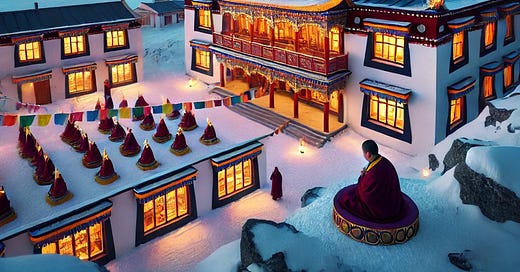TheGentleLaw Community
Buddhism is often associated with the serene temples of Japan, the towering monasteries of Tibet, and the lush forests of Thailand. However, few people know that Buddhism has also found a home in the far north, beyond the Arctic Circle. The northernmost Buddhist monastery in the world is Karma Berchen Ling, a Tibetan Buddhist retreat center in Tromsø, Norway. This small but significant center stands as a testament to Buddhism’s ability to adapt to even the harshest environments.
Karma Berchen Ling: A Buddhist Sanctuary in the Arctic
Located in Tromsø, Norway, Karma Berchen Ling belongs to the Karma Kagyu tradition of Tibetan Buddhism. It was established to provide a retreat space for serious practitioners and monastics, allowing them to engage in deep meditation and study far from the distractions of modern life. The monastery's location—north of the Arctic Circle—makes it an unusual yet peaceful setting for spiritual practice.
Life at the Monastery
Practicing Buddhism in an Arctic environment presents unique challenges and opportunities:
Winter Darkness & Summer Light: The region experiences extreme light conditions, with the midnight sun in summer and the polar night in winter. Monks and practitioners must adapt their meditation schedules to these unusual cycles.
Silence and Solitude: The monastery’s remote setting provides an ideal retreat for meditation and self-reflection, free from the noise and distractions of urban life.
Cold Weather Practice: Unlike the temperate climates of traditional Buddhist lands, practitioners here must adapt to freezing temperatures and heavy snowfall, making inner warmth and resilience essential aspects of practice.
Other Northern Buddhist Centers
While Karma Berchen Ling is the northernmost Buddhist retreat center, other Buddhist centers exist in the Arctic region:
Jigme Lingpa Buddhist Center (Murmansk, Russia): A Tibetan Buddhist center offering teachings and meditation in one of Russia’s northernmost cities.
Buddhist Centers in Alaska: Although Alaska has no traditional monasteries, Buddhist practice is growing in cities like Anchorage, where the White Lotus Center provides meditation and Dharma teachings.
Why Buddhism in the Arctic?
Buddhism’s presence in the Arctic demonstrates its adaptability. Unlike other major religions, Buddhism does not require a specific cultural or environmental setting—it flourishes wherever people seek wisdom, compassion, and inner peace. The quiet landscapes and vast, untouched wilderness of the north provide a natural setting for deep meditation, much like the isolated mountain caves where Buddhist monks have meditated for centuries.
The Future of Buddhism in the Arctic
Despite its remote location, Karma Berchen Ling attracts practitioners from around the world. As interest in Buddhism grows in the West, even these northern retreats may see increased activity. Whether monks in the Himalayas or practitioners in the Arctic, the search for enlightenment continues across all corners of the globe.
Buddhism in the Arctic Circle may be little known, but it serves as a powerful reminder that the Dharma knows no borders. It thrives wherever there is dedication, silence, and the willingness to look inward—even in the land of ice and snow.





